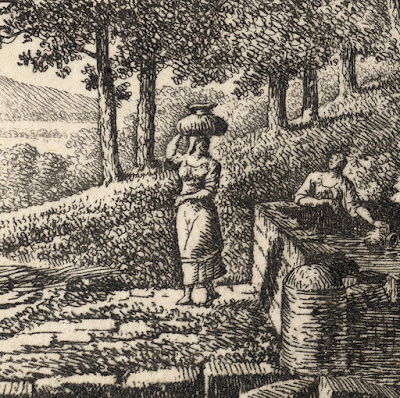Alexandre Hyacinthe Dunouy (1757–1841)
“Italian Landscape with Women by a
Spring”, c1800, the final plate in a suite of twelve etchings depicting various
Italian landscapes.
Etching on wove paper, trimmed with a narrow margin around the image borderline and re-margined with a support sheet.
Size: (support sheet) 17 x 21.9 cm;
(sheet) 10.1 x 14.8 cm; (image borderline) 9.7 x 14.2 cm
Inscribed on plate below the image
borderline: (left) “AD.” (the artist’s monogram); (right) “No. 12.”
See the description of this print offered by the Philadelphia Museum of Art: http://philamuseum.org/collections/permanent/3493.html?mulR=2136273041|23
Condition: faultless early impression
(based on the crispness of the lines—compare the strength of this impression
with the copy held by the Philadelphia Museum of Art [1985-52-9880]), trimmed with a narrow margin around the image borderline and re-margined with a support sheet
of archival (millennium quality) washi paper. The sheet is in near pristine
condition (i.e. there are no tears, holes, creases, abrasions, stains or
foxing).
I am selling this beautifully composed poetic
vision of a classical Italian landscape bathed in light for the
total cost of AU$154 (currently US$114.32/EUR98.12/GBP86.25 at the time of
posting this print) including postage and handling to anywhere in the world
(but not, of course, any import duties/taxes imposed by some countries).
If you are interested in purchasing this
superb example of a classical Italian composition (albeit from the perception
of a French artist), please contact me (oz_jim@printsandprinciples.com) and I
will send you a PayPal invoice to make the payment easy.
This print has been sold
What I love about this small etching is
that it glows with light—in fact I see the portrayed landscape as sparkling
with sunlight. Interestingly, the luminosity of the print does not rely to any
great degree on the traditional formula of sunlight falling from the
top-front-left with areas of strong tonal contrast giving drama to the scene—although I must admit that the light does illuminate the
woodland from the left. Instead, Dunouy uses the abutment of a
dark background behind the lit side of the featured subjects and a light
background beside the shadow side of the same subject. See for example how the
juxtaposition of lights and darks in the background behind the water-carrying figure
are played in much the same way that Seurat was later to adopt in his paintings:
the principle of contrast between what Paul Klee termed “exotopic” and “endotopic”
tones.







No comments:
Post a Comment
Please let me know your thoughts, advice about inaccuracies (including typos) and additional information that you would like to add to any post.